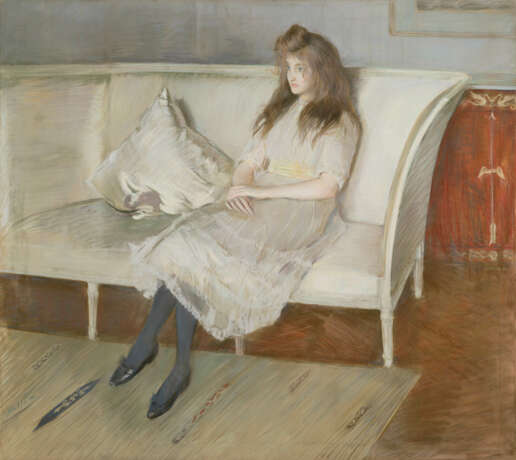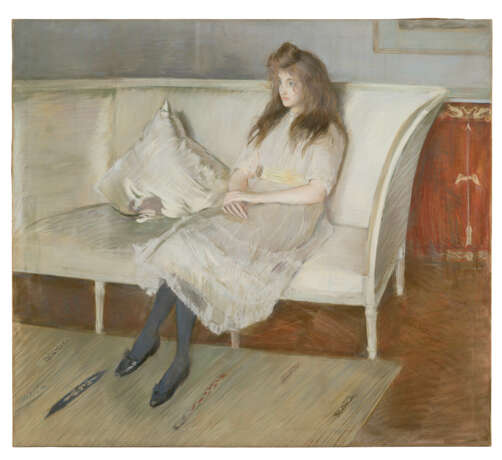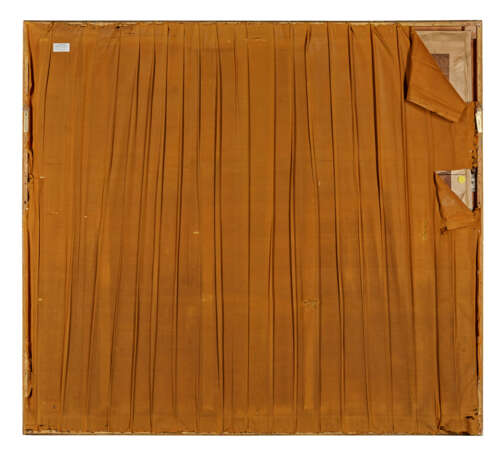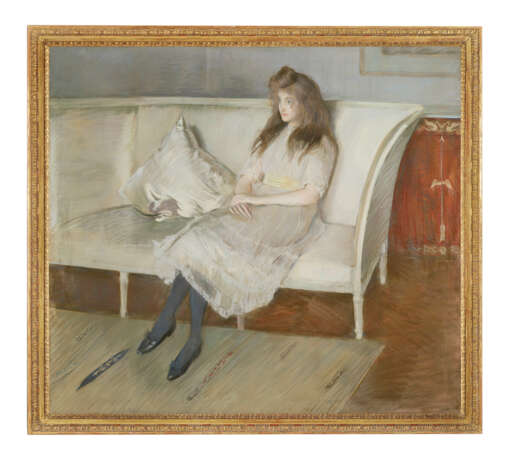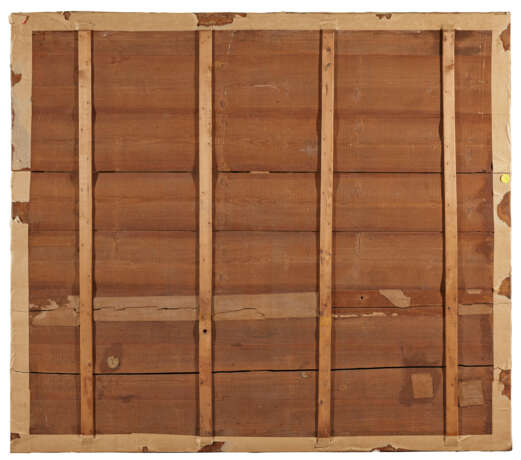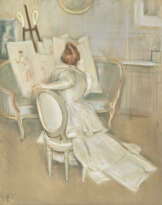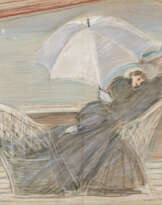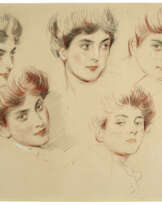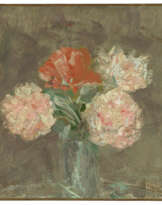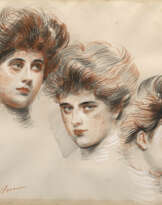ID 1178629
Lot 165 | Paul-César Helleu (1859-1927)
Estimate value
€ 50 000 – 70 000
Jeune fille assise sur un canapé dit ‘Symphonie en blanc, Mademoiselle Paulmier’
signé ‘Helleu’ (en bas à gauche)
pastel sur toile de lin monté sur châssis
168 x 181 cm
Exécuté vers 1895
signed 'Helleu' (lower left)
pastel on linen mounted on a stretcher
66 1⁄8 x 71 ¼ in.
Executed circa 1895
Provenance
Charles-Ernest Paulmier (1885-1907), père d'Yvonne Paulmier, future Baronne de Marçay, puis par descendance et par alliance, sa femme Valentine Bouillant (1858-1932) mariée en seconde noce avec
Jules-Albert de Dion (1856-1946).
Agnès Aignan, compagne d'Yvonne Paulmier.
Vente Sotheby’s, Londres, 15 juin 1982, lot 85.
Galerie Agnew & Sons Ltd, Londres, 1983, d'où acquis par Paul Josefowitz, Suisse.
Literature
F. de Watrigant (dir.), Paul-César Helleu, Paris, Lausanne, 2014, p. 243. ill.
Les Amis de Paul-César Helleu, Paul Helleu, catalogue raisonné, en ligne, n° PA -1428.
Exhibited
Lausanne, Fondation de l'Hermitage, Pastels du XVIe au XXIe siècle, février-mai 2018, pp. 100-101, no. 61.
Further details
Paul-César Helleu figure parmi les plus importants portraitistes de son temps avec ses amis John Singer Sargent et Giovanni Boldini. Apprécié par la haute société française et internationale, il préfère surtout représenter les modèles féminins, comme la jeune fille portraituré dans la présente composition, Yvonne Paulmier, fille de l’avocat et homme politique Charles-Ernest Paulmier (1848-1907). Réalisé en 1885, cette année est marquée par la participation de Helleu au Salon des pastellistes à Paris où il expose le Portrait d’Alice Louis Guérin, sa future jeune épouse (musée Bonnat-Helleu, Bayonne, inv. CMNI 3037).
Le présent pastel illustre à merveille le raffinement et la délicatesse des figures, aspects pour lesquels ses portraits de femmes sont tant estimés par le public de l’époque. Le titre Symphonie en blanc traduit le remarquable rendu des blancs de la robe et du canapé associés à des tonalités de gris, de beige et d’ocre. La robe blanche pourrait être une référence à Watteau et à sa maîtrise de la représentation des tissus. D’ailleurs, selon Frédérique de Watrigant, Helleu se rend en Angleterre en 1885 et se trouve attiré par le goût de la blancheur des murs des intérieurs anglais (F. de Watrigant, Paul-César Helleu, Paris, 2012, p. 91, pp. 239-240). Helleu réalise également en 1885 un pastel, Jeune fille en blanc (portrait présumé de la princesse de Ligne) (collection Hays, Nashville, New York ; voir Les Amis de Paul-César Helleu, Paul Helleu, catalogue raisonné, en ligne, n° PA-1543), où le modèle est accompagné de fleurs blanches.
Le présent portrait a été réalisé dans la maison de l’artiste, comme l’atteste le canapé qui figure dans le catalogue de la vente après décès de Helleu en 1928. Le foyer de Helleu était aménagé dans un goût néoclassique rassemblant des objets de différentes périodes. Ce style a notamment été ‘remis à la mode’ par Edmond de Goncourt, ami de Helleu (F. Watrigant, op. cit., pp. 238-242).
Le cadrage atypique resserré sur la jeune femme et le canapé sans dégagement autour dans la pièce confère une intimité particulière à cette scène. L’expression de visage de mademoiselle Paulmier est également peu commune : contrairement à de nombreux portraits de jeunes femmes souriantes, ici, son regard froid et absent fixe l’horizon tandis que sa pose hiératique amplifie cette tension intense qui se dégage du pastel.
Paul-César Helleu was one of the most important portrait painters of his time, along with his friends John Singer Sargent and Giovanni Boldini. Appreciated by French and international high society, he preferred to depict female models, such as the young girl in the present composition, Yvonne Paulmier, daughter of the lawyer and politician Charles-Ernest Paulmier (1848-1907). Executed in 1885, this year was marked by Helleu's participation in the Salon des pastellistes in Paris, where he exhibited the Portrait of Alice Louis Guérin, his future wife (Musée Bonnat-Helleu, Bayonne, inv. CMNI 3037).
The present pastel perfectly illustrates the refinement and delicacy of the figures, aspects for which his portraits of women were so highly esteemed by the public of the time. The title Symphonie en blanc reflects the remarkable rendering of the whites of the dress and sofa, combined with tones of grey, beige and ochre. The white dress could be a reference to Watteau and his mastery of fabric representation. In fact, according to Frédérique de Watrigant, Helleu visited England in 1885 and was attracted by the taste for white walls in English interiors (F. de Watrigant, Paul-César Helleu, Paris, 2012, p. 91, pp. 239-240). In 1885, Helleu also produced a pastel, Jeune fille en blanc (portrait présumé de la princesse de Ligne) (Hays Collection, Nashville, New York; see Les Amis de Paul-César Helleu, Paul Helleu, catalog raisonné, online, no. PA-1543), in which the model is accompanied by white flowers.
The present portrait was painted in the artist's home, as evidenced by the sofa featured in the catalogue of the 1928 sale of Helleu's estate after his death. Helleu's home was furnished in a neoclassical style, bringing together objects from different periods. This style was brought back into fashion by Edmond de Goncourt, a friend of Helleu's (F. Watrigant, op. cit., pp. 238-242).
The atypically tight framing of the young woman and the room's uncluttered sofa lend a particular intimacy to this scene. Mademoiselle Paulmier's facial expression is also unusual: unlike many portraits of smiling young women, here her cold, absent gaze stares out at the horizon, while her hieratic pose amplifies the intense tension that emanates from the pastel. Finally, this pastel is singular in the distant viewpoint with which Helleu depicts Yvonne Paulmier, and in the care taken in depicting the room's décor.
| Artist: | Paul César Helleu (1859 - 1927) |
|---|---|
| Place of origin: | Western Europe, France, Europe |
| Auction house category: | All other types of objects, Paintings, Watercolors, Drawings, Drawings, Watercolors and drawings |
| Artist: | Paul César Helleu (1859 - 1927) |
|---|---|
| Place of origin: | Western Europe, France, Europe |
| Auction house category: | All other types of objects, Paintings, Watercolors, Drawings, Drawings, Watercolors and drawings |
| Address of auction |
CHRISTIE'S 9 Avenue Matignon 75008 Paris France | ||||||||||||||
|---|---|---|---|---|---|---|---|---|---|---|---|---|---|---|---|
| Preview |
| ||||||||||||||
| Phone | +33 (0)1 40 76 85 85 | ||||||||||||||
| Fax | +33 (0)1 40 76 85 86 | ||||||||||||||
| Conditions of purchase | Conditions of purchase | ||||||||||||||
| Shipping |
Postal service Courier service pickup by yourself | ||||||||||||||
| Payment methods |
Wire Transfer | ||||||||||||||
| Business hours | Business hours
|
